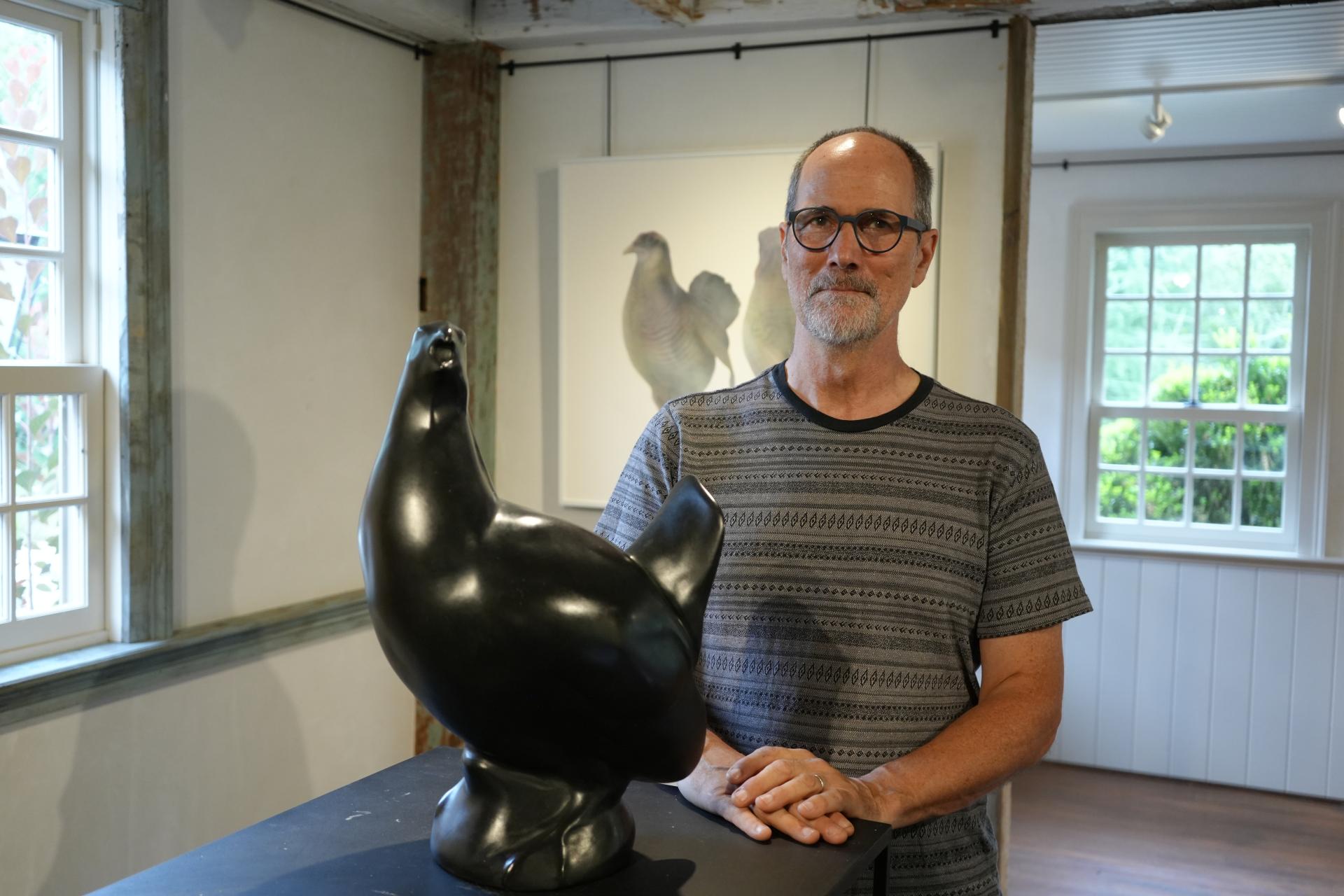You are here
The Lost Bird Project: With a Fist Full of Clay, He Began His Own Exploration
The Lost Bird Project: With a Fist Full of Clay, He Began His Own Exploration
A centerpiece in Berkshire Botanical Garden’s “Lost and Found” Art/Garden theme this season is Todd McGrain’s “The Lost Bird Project” consisting of both indoor and outdoor artwork. Since 2000, McGrain has created permanent memorials to birds driven to extinction in modern times. Collaborating with local communities, he’s placed memorials at sites with direct significance to the life of each species. In most cases, these sites are the locations where the birds were last seen in the wild.
The outdoor exhibit at BBG runs from June 1 through Oct. 6, and consists of large-scale bronze sculptures that are castings of those original memorials. They include monuments to the passenger pigeon, the Carolina parakeet, the Labrador duck, the great auk, and the heath hen. The indoor exhibit in the Leonhardt Galleries runs from Aug. 10 through Oct. 6, and consists of photographs, drawings and paintings McGrain created during his research at several museum collections. As he prepared for his exhibition, McGrain, a Guggenheim Memorial Fellowship recipient who lives in Richmond, Ore., took time to answer some questions from Cuttings:
How did you come to focus on vanished species in general and these species in particular?
My first real introduction to these lost birds came from John James Audubon’s illustrations. Audubon’s compassionate image of the passenger pigeon has had a particularly lasting impact. There are many birds in the world, birds that we can hear and see, count and study. I am a casual birder and enjoy watching migratory visitors. These living birds, however, have never found their way into my imagination quite the way the lost birds have. Perhaps it was their absence that led me to them, that compelled me to shape my first small model of a preening Labrador duck. Perhaps it was the challenge of finding form for the formless. I have always turned to the studio to find purpose for complex thoughts and emotions. And so, with a fist full of clay, I began my own exploration.
Ideally, what reaction do you hope to elicit with your work?
One of the wonderful things about the visual arts is that each viewer brings with them their own perspective, which shapes the collective meaning of the work. My interpretation of the Lost Bird sculptures is that they are, as a group, melancholy, yet affirming. They compel us to recognize the finality of our loss. They ask us not to forget them, and they remind us of our duty to prevent further extinction.
Is there one species represented whose story particularly breaks your heart or that you are particularly moved by?
To me the narrative of each of these bird’s decline is compelling. Before I heard or read the stories of the lost birds, I did not know to miss them. I had no sympathy for them or for any of us who have lost the opportunity to witness the vitality of their lives.
What we can know of these birds comes to us now through history, literature, scientific inquiry, and art. From pioneering ornithologists, we learn that the passenger pigeon flocks were once so vast that they darkened the midday sky, and that the Labrador ducks’ wings whistled when they flew. In paintings we see the Carolina parakeet, vibrant as a tropical flower, and the heath hen, tawny to match the colors of a New England autumn. Excavated bones of the great auk help us piece together its rather unlikely posture. We struggle to imagine the wonder of seeing flocks of this penguin-like bird scrambling across the rocks of our rugged northern coastline. It is perhaps this bird, the great auk, that I currently find most compelling.
Why this particular art show at this particular location, Berkshire Botanical Garden?
The Berkshire Botanical Garden is an ideal location for The Lost Bird Project exhibit. The passenger pigeon and the heath hen would have both been common birds in this region. In a way it is a homecoming. Perhaps the memorials’ presence here will help us imagine this garden cast in shadow by a great flock of passenger pigeons. Perhaps we can still bring ourselves to conjure the sound of a flock of heath hens welcoming the dawn with its haunting, cooing morning choir.
Why are you drawn to bronze?
Though bronze casting is an ancient process, it remains one of the most pliable and durable sculpting materials. The cast form flawlessly captures the subtlety of my original clay figures.
Is there a reason why have you chosen to make the works’ surfaces smooth?
For me, this smooth surface, like a stone polished by sea and sand, conjures the effect of memory and time. The gestural forms contain a taut equilibrium, a balanced pressure from outside and from inside — like a breath held in.
Since these works were created as memorials, would you explain why you chose the scale you did — essentially making them about human height?
The human scale of each sculpture elicits a physical sympathy. They are too big to completely possess, but not so big as to dominate.
Help Our Garden Grow!
Your donation helps us to educate and inspire visitors of all ages on the art and science of gardening and the preservation of our environment.
All donations are 100 percent tax deductible.




